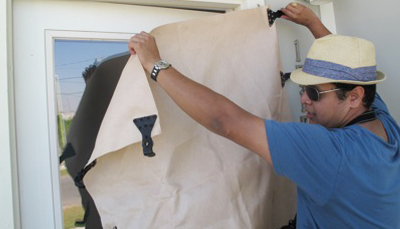This fact sheet contains health and safety tips for families preparing for a hurricane from the U.S. Department of Health and Human Services and its agencies, including the Centers for Disease Control and Prevention and Food and Drug Administration.
Hurricanes and Your Health and Safety
The great majority of injuries during a hurricane are cuts caused by flying glass or other debris. Other injuries include puncture wounds resulting from exposed nails, metal, or glass, and bone fractures.
State and local health departments may issue health advisories or recommendations particular to local conditions. If in doubt, contact your local or state health department.
Make sure to include all essential medications — both prescription and over the counter — in your family””s emergency disaster kit.
Water Quality
Hurricanes, especially if accompanied by a tidal surge or flooding, can contaminate the public water supply. Drinking contaminated water may cause illness. You cannot assume that the water in the hurricane-affected area is safe to drink.
In the area hit by a hurricane, water treatment plants may not be operating; even if they are, storm damage and flooding can contaminate water lines. Listen for public announcements about the safety of the municipal water supply.
If your well has been flooded, it needs to be tested and disinfected after the storm passes and the floodwaters recede. Questions about testing should be directed to your local or state health department.
Water Safety

Use bottled water that has not been exposed to flood waters if it is available.
If you don’t have bottled water, you should boil water to make it safe. Boiling water will kill most types of disease-causing organisms that may be present. If the water is cloudy, filter it through clean cloths or allow it to settle, and draw off the clear water for boiling. Boil the water for one minute, let it cool, and store it in clean containers with covers.
If you can’t boil water, you can disinfect it using household bleach. Bleach will kill some, but not all, types of disease-causing organisms that may be in the water. If the water is cloudy, filter it through clean cloths or allow it to settle, and draw off the clear water for disinfection. Add 1/8 teaspoon (or 8 drops) of regular, unscented, liquid household bleach for each gallon of water, stir it well and let it stand for 30 minutes before you use it. Store disinfected water in clean containers with covers.
If you have a well that has been flooded, the water should be tested and disinfected after flood waters recede. If you suspect that your well may be contaminated, contact your local or state health department or agriculture extension agent for specific advice.
Food Safety
Do not eat any food that may have come into contact with flood water.
Discard any food that is not in a waterproof container if there is any chance that it has come into contact with flood water. Food containers that are not waterproof include those with screw-caps, snap lids, pull tops, and crimped caps. Also, discard cardboard juice/milk/baby formula boxes and home canned foods if they have come in contact with flood water, because they cannot be effectively cleaned and sanitized.
Inspect canned foods and discard any food in damaged cans. Can damage is shown by swelling; leakage; punctures; holes; fractures; extensive deep rusting; or crushing/denting severe enough to prevent normal stacking or opening with a manual, wheel-type can opener.
Undamaged, commercially prepared foods in all-metal cans and retort pouches (for example, flexible, shelf-stable juice or seafood pouches) can be saved if you do the following:
Remove the labels, if they are the removable kind, since they can harbor dirt and bacteria.
Thoroughly wash the cans or retort pouches with soap and water, using hot water if it is available.
Brush or wipe away any dirt or silt.
Rinse the cans or retort pouches with water that is safe for drinking, if available, since dirt or residual soap will reduce the effectiveness of chlorine sanitation.
Then, sanitize them by immersion in one of the two following ways:
- place in water and allow the water to come to a boil and continue boiling for 2 minutes, or
- place in a freshly-made solution consisting of 1 tablespoon of unscented liquid chlorine bleach per gallon of drinking water (or the cleanest, clearest water available) for 15 minutes.
Air dry cans or retort pouches for a minimum of 1 hour before opening or storing.
If the labels were removable, then re-label your cans or retort pouches, including the expiration date (if available), with a marker.
Food in reconditioned cans or retort pouches should be used as soon as possible, thereafter.
Any concentrated baby formula in reconditioned, all-metal containers must be diluted with clean, drinking water.
Thoroughly wash metal pans, ceramic dishes, and utensils (including can openers) with soap and water, using hot water if available. Rinse, and then sanitize them by boiling in clean water or immersing them for 15 minutes in a solution of 1 tablespoon of unscented, liquid chlorine bleach per gallon of drinking water (or the cleanest, clearest water available).
Thoroughly wash countertops with soap and water, using hot water if available. Rinse, and then sanitize by applying a solution of 1 tablespoon of unscented, liquid chlorine bleach per gallon of drinking water (or the cleanest, clearest water available). Allow to air dry.
Frozen and Refrigerated Foods
If you will be without power for a long period:
ask friends to store your frozen foods in their freezers if they have electricity;
see if freezer space is available in a store, church, school, or commercial freezer that has electrical service; or
use dry ice, if available. Twenty-five pounds of dry ice will keep a ten-cubic-foot freezer below freezing for 3-4 days. Use care when handling dry ice, and wear dry, heavy gloves to avoid injury.
your refrigerator will keep foods cool for about four hours without power if it is unopened. Add block or dry ice to your refrigerator if the electricity will be off longer than four hours.
Thawed food can usually be eaten if it is still “refrigerator cold,” or re-frozen if it still contains ice crystals.
To be safe, remember, “When in doubt, throw it out.” Discard any food that has been at room temperature for two hours or more, and any food that has an unusual odor, color, or texture.
Sanitation and Hygiene

It is critical for you to remember to practice basic hygiene during the emergency period. Always wash your hands with soap and water that has been boiled or disinfected:
before preparing or eating
after toilet use
after participating in cleanup activities; and
after handling articles contaminated with floodwater or sewage.
If there is flooding along with a hurricane, the waters may contain fecal material from overflowing sewage systems and agricultural and industrial waste. Although skin contact with floodwater does not, by itself, pose a serious health risk, there is risk of disease from eating or drinking anything contaminated with floodwater. If you have any open cuts or sores that will be exposed to floodwater, keep them as clean as possible by washing them with soap and applying an antibiotic ointment to discourage infection. If a wound develops redness, swelling, or drainage, seek immediate medical attention.
Do not allow children to play in floodwater areas. Wash children’s hands frequently (always before meals), and do not allow children to play with floodwater-contaminated toys that have not been disinfected. You can disinfect toys using a solution of one cup of bleach in five gallons of water.
Immunizations
Outbreaks of communicable diseases after hurricanes are unusual. However, the rates of diseases that were present before a hurricane may increase because of a lack of sanitation or overcrowding in shelters. Increases in infectious diseases that were not present before the hurricane are not a problem, so mass vaccination programs are unnecessary.
If you have wounds, you should be evaluated for a tetanus immunization, just as you would at any other time of injury. If you receive a puncture wound or a wound contaminated with feces, soil, or saliva, have a doctor or health department determine whether a tetanus booster is necessary based on individual records.
Specific recommendations for vaccinations should be made on a case-by-case basis, or as determined by local and state health departments.
Mosquitoes
Rain and flooding in a hurricane area may lead to an increase in mosquitoes. Mosquitoes are most active at sunrise and sunset. In most cases, the mosquitoes will be pests but will not carry communicable diseases. It is unlikely that diseases which were not present in the area prior to the hurricane would be of concern. Local, state, and federal public health authorities will be actively working to control the spread of any mosquito-borne diseases.
To protect yourself from mosquitoes, use screens on dwellings, and wear clothes with long sleeves and long pants. Insect repellents that contain DEET are very effective. Be sure to read all instructions before using DEET. Care must be taken when using DEET on small children. Products containing DEET are available from stores and through local and state health departments.
To control mosquito populations, drain all standing water left in open containers outside your home.
Mental Health
The days and weeks after a hurricane are going to be rough. In addition to your physical health, you need to take some time to consider your mental health as well. Remember that some sleeplessness, anxiety, anger, hyperactivity, mild depression, or lethargy are normal, and may go away with time. If you feel any of these symptoms acutely, seek counseling. Remember that children need extra care and attention before, during, and after the storm. Be sure to locate a favorite toy or game for your child before the storm arrives to help maintain his/her sense of security. Your state and local health departments will help you find the local resources, including hospitals or health care providers, that you may need.
Quoted from U.S. Department of Health & Human Services
http://www.hhs.gov/news/facts/hurricane.html














